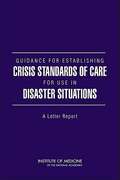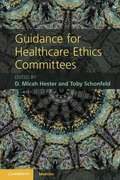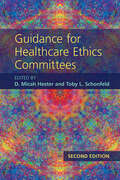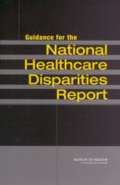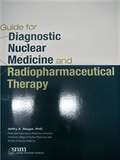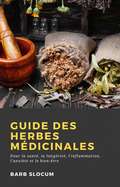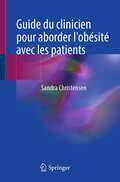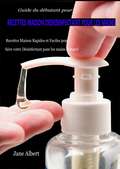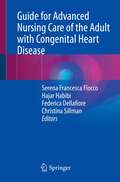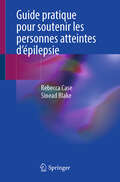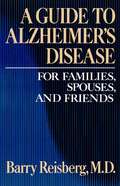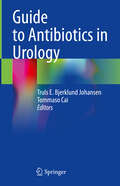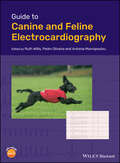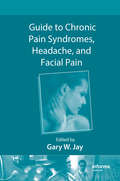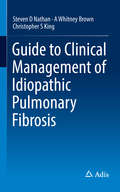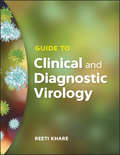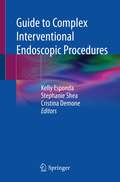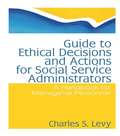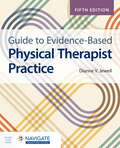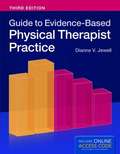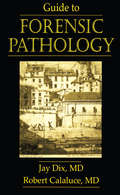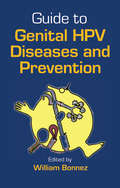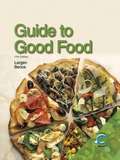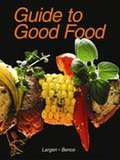- Table View
- List View
Guidance for Establishing Crisis Standards of Care for Use in Disaster Situations: A Letter Report
by Institute of MedicineThe influenza pandemic caused by the 2009 H1N1 virus underscores the immediate and critical need to prepare for a public health emergency in which thousands, tens of thousands, or even hundreds of thousands of people suddenly seek and require medical care in communities across the United States. Guidance for Establishing Crisis Standards of Care for Use in Disaster Situations draws from a broad spectrum of expertise--including state and local public health, emergency medicine and response, primary care, nursing, palliative care, ethics, the law, behavioral health, and risk communication--to offer guidance toward establishing standards of care that should apply to disaster situations, both naturally occurring and manmade, under conditions in which resources are scarce. Guidance for Establishing Crisis Standards of Care for Use in Disaster Situations explores two case studies that illustrate the application of the guidance and principles laid out in the report. One scenario focuses on a gradual-onset pandemic flu. The other scenario focuses on an earthquake and the particular issues that would arise during a no-notice event. Outlining current concepts and offering guidance, this book will prove an asset to state and local public health officials, healthcare facilities, and professionals in the development of systematic and comprehensive policies and protocols for standards of care in disasters where resources are scarce. In addition, the extensive "operations" section of the book provides guidance to clinicians, healthcare institutions, and state and local public health officials for how those crisis standards of care should be implemented in a disaster situation.
Guidance for Healthcare Ethics Committees
by D. Micah Hester Toby SchonfeldEvery accredited American hospital is required to have a mechanism for handling ethical concerns; most hospitals satisfy this requirement by constituting an institutional healthcare ethics committee (HEC), a pattern which is repeated in most western countries. This text provides definitive, comprehensive guidance for members of healthcare ethics committees who find themselves confronted with ethically challenging situations. Each chapter includes learning objectives, clinical case studies and questions to stimulate discussion among committee members. Particular emphasis is given to consultation, as this often presents the greatest challenges to committee members. Each chapter stands alone as a teaching module, as well as forming part of a comprehensive volume. Written and edited by nationally and internationally recognized experts in bioethics, this is essential reading for every member of a healthcare ethics committee.
Guidance for the National Healthcare Disparities Report
by Committee on Guidance for Designing A National Healthcare Disparities ReportA report on the Guidance for the National Healthcare Disparities Report
Guide For Diagnostic Nuclear Medicine And Radiopharmaceutical Therapy
by Jeffry A. Siegel Society of Nuclear Medicine (1953- ) StaffGuide for Diagnostic Nuclear Medicine and Radiopharmaceutical Therapy
Guide des Herbes Médicinales: Pour la santé, la longévité, l'inflammation, l'anxiété et le bien-être
by Barb SlocumSoigner les blessures, soulager les douleurs, réparer la digestion lente, perte de poids et réduire le stress. Être en bonne santé! Ce ne sont que quelques-uns des remèdes à base de plantes qui seront abordés dans ce livre. Barb Slocum vous montre à quel point il est simple de préparer des remèdes à base de plantes avec des plantes simples et facilement disponibles. Ces mélanges sont sans danger et il a été prouvé que ceux-ci permettent de guérir plusieurs maux en toute sécurité. Remplacez vos médicaments par des herbes naturelles, moins addictives et cicatrisantes, qui constituent une alternative moins coûteuse et moins chère à la cicatrisation. Avertissement: Ce guide doit être utilisé uniquement à titre de référence. Si vous avez des conditions préexistantes, vous devriez consulter un professionnel de la santé avant d'utiliser l'un de ces remèdes à base de plantes.
Guide des Soins de la Peau
by Laurie LarsonAvez-vous une peau sensible? Souhaitez-vous améliorer votre apparence? Dans ce guide vous recevrez les conseils les plus efficaces et les plus économiques pour vous transformer en modèle! Ces méthodes sont couramment utilisées par les meilleurs modèles du monde et peuvent être appliquées même par un novice en quelques minutes seulement. Voici ce qui est inclus: - Sois plus jeune que jamais! - Astuces simples - Méthodes à faibles coût - Prenez soin de votre peau en quelques minutes chaque jour. Faites défiler vers le haut de la page et cliquez sur Ajouter au panier pour acheter instantanément.
Guide du clinicien pour aborder l'obésité avec les patients
by Sandra ChristensenCet ouvrage pratique, traduit de l’anglais, offre des stratégies efficaces, applicables dans n’importe quel cadre de pratique, pour amorcer et entretenir une conversation constructive sur le poids avec un patient. Il est destiné aux praticiens, infirmiers de pratique avancée, assistants médicaux, médecins, qu’ils soient étudiants ou professionnels expérimentés, pour les aider à prendre en charge le suivi de l'obésité ou pour orienter leurs patients vers d'autres professionnels.Ce guide aborde les nombreux obstacles que les praticiens rencontrent lorsqu'ils abordent la question du poids et propose des stratégies pour les contourner et les surmonter. Il accompagne les cliniciens pas à pas dans l’acquisition des concepts et compétences nécessaires à mener une discussion qui conduira à améliorer la santé du patient. Chaque chapitre fournit des outils et informations sur la manière de faire habilement progresser une conversation, de façon respectueuse. Des cas cliniques réels fournissent des exemples de conversations courtes et concrètes qui intègrent ces outils dans la pratique clinique. De nombreux praticiens sont conscients de l'importance d'aborder la question du poids avec leurs patients, mais ne se sentent pas suffisamment préparés pour le faire. Beaucoup n’ont pas été formés à la question de l'obésité, ni à la meilleure manière d’en parler et n'ont que peu d'accès à la formation continue. Sans les connaissances et compétences nécessaires pour aborder une conversation constructive, beaucoup évitent le sujet, ce qui impacte négativement la santé des personnes souffrant d'obésité et de pré-obésité. Le suivi et le traitement de cette pathologie donnant de bons résultats, il est impératif que les praticiens soient capables d'aborder cette question en connaissance de cause et avec sensibilité. A ce titre, ce guide pratique comble cette lacune.
Guide du débutant pour RECETTES FAIT MAISON DE DESINFECTANT POUR LES MAINS: Recettes Rapides et Faciles pour faire votre Désinfectant Naturel pour les mains fait maison
by Petcha JulietteLe désinfectant commercial pour les mains devient cher, et avec la pénurie de désinfectant pour les mains due au COVID-19, vous devrez peut-être recourir à la fabrication du vôtre. La fabrication de votre propre désinfectant pour les mains est un processus simple qui se traduit par une formule que vous pouvez personnaliser en fonction de vos goûts personnels. Le CDC recommande de se laver les mains pendant au moins 20 secondes plusieurs fois par jour, mais la réalité de la vie peut vous gêner (en déplacement, en avion, en train ou en métro, vous avez l'argument) - et c'est à ce moment qu'un désinfectant pour les mains est nécessaire. Bien qu'il existe plusieurs versions sans alcool de désinfectants pour les mains sur le marché, le CDC en recommande une qui contient au moins 60% d'alcool pour une efficacité maximale - et tous ces produits sont soit vendus chez des détaillants locaux (au moins à Los Angeles), soit 10-20 fois leur prix normal. Certains désinfectants pour les mains commerciaux contiennent des ingrédients aussi effrayants que les germes dont ils vous protègent, alors pourquoi ne pas fabriquer votre propre désinfectant pour les mains à partir d'ingrédients que vous sélectionnez en quelques étapes faciles. Voici un aperçu de ce que vous apprendrez: Préoccupations liées à la Sécurité des Désinfectants pour les mains -Efficacité des désinfectants pour les mains -Diverses recettes maison de désinfectant pour les mains -Recette de l'Organisation Mondiale de la Santé (OMS) pour créer un désinfectant pour les mains à base d'alcool -Comment faire du gel d'aloe vera -Technique correcte de lavage des mains -Conseils pour utiliser plus efficacement le désinfectant pour les mains Et bien plus!
Guide for Advanced Nursing Care of the Adult with Congenital Heart Disease
by Serena Francesca Flocco Federica Dellafiore Hajar Habibi Christina SillmanThe aim of this book is to provide one central resource for nurses within the adult spectrum of life-long congenital heart disease care who are seeking expert guidance for their practice, regardless of clinical setting. Over the past 50 years, advances in surgical techniques and medical therapies have drastically improved the number of congenital heart disease patients surviving into adulthood, with the result being that there are now more adults then children living with congenital heart disease. In the past three decades, recognition of this new cardiology subspecialty has given way to formalized programs, standards of care, and multidisciplinary expertise. Indeed Nursing care of adult patients with congenital heart disease (ACHD) is a relatively new medical subspecialty with limited knowledge and guidance available and also an important component of the multidisciplinary care team. Nursing care of the ACHD encompasses a holistic approach to the physical, psychological, social, and spiritual wellbeing of these unique individuals across their lifespan. Understanding the intricacies for the various heterogeneous defect types, the transition from pediatric to adult care, the unique educational and self-care needs, life-events such as pregnancy/reproduction, advanced heart failure, and end-of-life care helps prepare the nurse caring for the ACHD patient. Nurses as a first point of care for the ACHD patients play a pivotal role in the education and empowerment of the ACHD patient population and provide an invaluable role in the multidisciplinary team and with this guide nurses can feel confident in the quality of the care they provide. This book aims to introduce nursing focused care to wider audiences, nurses, medical technicians, and physicians who are involved in the management and treatment of ACHD patients. Improving care and the quality of life for adult congenital heart disease patients with a multidisciplinary team-based approach, including nursing care, should be a central goal for all ACHD programs.
Guide pratique pour soutenir les personnes atteintes d'épilepsie
by Rebecca Case Sinead BlakeCe guide pratique propose une réflexion sur le soutien à apporter aux personnes atteintes d’épilepsie. Il englobe les directives britanniques sur l’épilepsie du NICE (National Institute for Health and Care Excellence) (2012, révisées en 2019), la loi sur l’égalité (2010), la loi sur les enfants et les familles (2014), les pratiques actuelles fondées sur des données probantes et les normes des organismes de réglementation. Il s’adresse principalement aux infirmières et aux étudiantes-infirmières, en particulier à celles qui étudient les troubles de l’apprentissage, mais aussi aux services à domicile, d’accueil temporaire et d’aide à la vie quotidienne, aux écoles et aux aidants familiaux, afin de leur permettre d’offrir un soutien approprié et fondé sur des données probantes aux patients de tous âges. On estime à environ 1 200 le nombre de décès liés à l’épilepsie chaque année au Royaume-Uni. Nombre d’entre eux seraient évitables. Des cas très médiatisés ont suscité un certain émoi chez les soignants et ont conduit à un examen plus minutieux des services de soins par les organismes de réglementation. Au fil des ans, les autrices se sont vu poser les mêmes questions et ont été témoins des mêmes malentendus et erreurs de la part des personnes qui aident les épileptiques. Elles se sont donc penchées sur les points récurrents et les ressources disponibles. Il est apparu que les informations nécessaires pour combler ces lacunes sont disponibles, mais difficilement accessibles. Il existe de nombreuses informations dans le domaine public, mais la plupart d’entre elles sont factuelles, plutôt que pratiques. Cet ouvrage offre des informations et des ressources pratiques en mettant l’accent sur « ce qu’il faut faire », « comment le faire » et « qui doit le faire ». Cet ouvrage est utile pour soutenir les personnes épileptiques partout dans le monde.
Guide to Alzheimer's Disease
by Barry ReisbergAn excellent and intelligent book for the families of patients with Alzheimer's disease.
Guide to Antibiotics in Urology
by Tommaso Cai Truls E. Bjerklund JohansenThis book provides a comprehensive analysis of the use of antibiotics in the urological setting. It is the first work to focus exclusively on the treatment of urinary tract infections, starting from the recent epidemiological and microbiological acquisitions in terms of bacterial resistance. The structure of the book reflects everyday clinical practice, and the sections are divided in line with the level of clinical severity, starting from the uncomplicated lower urinary tract infections and continuing to severe uro-sepsis. Particular emphasis has been given to patient-related risk factors, to the role of antibiotic prophylaxis in urological surgical procedures, and to the treatment of male associated gland infections. The final section offers a dedicated tool for easy and rapid consultation, helping physicians in the everyday clinical practice setting. The book offers the first practical guide for physicians who treat patients affectedby urological infections. Further, it offers a simple guide to consulting for all physicians who occasionally care for these patients.
Guide to Canine and Feline Electrocardiography
by Ruth Willis Pedro Oliveira Antonia MavropoulouGuide to Canine and Feline Electrocardiography offers a comprehensive and readable guide to the diagnosis and treatment of abnormal heart rhythms in cats and dogs. Covers all aspects of electrocardiography, from basics to advanced concepts of interest to specialists Explains how to obtain high-quality electrocardiograms Offers expert insight and guidance on the diagnosis and treatment of simple and complex arrhythmias alike Features numerous case examples, with electrocardiograms and Holter monitor recordings Shows the characteristics of normal and abnormal heart rhythms in dogs and cats Includes access to a website with self-assessment questions and the appendices and figures from the book
Guide to Chronic Pain Syndromes, Headache, and Facial Pain
by Gary W. JayThis set provides clinicians with key information on all types of pain: pain syndromes that result from specific conditions; chronic pain from the neck down; and chronic headache and facial pain. Why every practicing clinician needs a copy of this comprehensive set: EVIDENCE-BASED AND CLINICALLY ORIENTED - provide pertinent, useful data you need to make accurate diagnoses and develop the best treatment plans for your patients COMPREHENSIVE CONTENT - with 48 chapters on pain syndromes from head-to-toe and detailed treatment strategies, you'll have all the information you need to improve patient outcomes USER-FRIENDLY FORMAT - with data organized by pain type, you can easily reference critical information on-the-go AUTHORITATIVE CLINICAL GUIDANCE - over 25 experts in pain management give you the advice you trust to implement in your daily practice.
Guide to Clinical Management of Idiopathic Pulmonary Fibrosis
by Steven D Nathan A Whitney Brown Christopher S KingThis clinically focused pocket guide offers a concise yet complete overview of idiopathic pulmonary fibrosis, covering the most recent information on aspects such as pathophysiology, management, treatment, and clinical trials. The text is easily accessible and offers pulmonologists and other health care professionals with an excellent quick reference tool. Full color images and figures enhance and summarize key aspects of the text. Idiopathic pulmonary fibrosis is a condition that affects the alveoli and leads to serious lung damage, and the idiopathic nature of this disease means that the origin or cause is unknown. This disease is relatively rare, affecting 3 in 10,000 people, but it is becoming more common. Physicians should be aware of the early stages and symptoms of this disease so management strategies can be implemented quickly, and the best treatment can be administered.
Guide to Clinical and Diagnostic Virology (ASM Books)
by Reeti KhareThe explosion in clinical testing has been especially rapid in virology, where emerging viruses and growing numbers of viral infections are driving advances. The Guide to Clinical and Diagnostic Virology offers a digestible view of the breadth and depth of information related to clinical virology, providing a practical, working knowledge of the wide array of viruses that cause human disease. Introductory chapters cover the basics of clinical virology and laboratory diagnosis of infections, including virus structure, life cycle, transmission, taxonomy, specimen types and handling, and a comparison of assays used for detection. Detailed sections on important topics include Viral pathogens and their clinical presentations Diagnostic assays and techniques, including culture-based, immunological, and molecular Prevention and management of viral infections, with guidance on biosafety, vaccines, and antiviral therapies The regulatory environment for laboratory testing, including regulatory requirements and assay performance and interpretation Critical concepts are carefully curated and concisely summarized and presented with detailed illustrations that aid comprehension, along with important highlights and helpful hints. These features, plus question sections that reinforce significant ideas and key concepts, make this an invaluable text for anyone looking for an accessible route through clinical and diagnostic virology. Laboratory technologists, medical students, infectious disease and microbiology fellows, pathology residents, researchers, and everyone involved with viruses in the clinical setting will find the Guide to Clinical and Diagnostic Virology an excellent text as well as companion to clinical virology references.
Guide to Complex Interventional Endoscopic Procedures
by Kelly Esponda Stephanie Shea Cristina DemoneThis guide walks you through the set-up, supplies, nursing considerations, troubleshooting, and steps to successfully assist during cutting edge interventional Gastroenterological procedures that are being performed to offer patients a safer and more cost effective treatment option. This key resource contributes, as the first of its kind, by helping endoscopic surgical centers to prepare for and train staff in order to offer these new and on the rise procedures to their patients. It goes into detail on each procedure and why a patient would benefit from it. Pictures will be included to demonstrate what the procedure will look like. A detailed step-by-step manual including photos will be put together on each case describing the set-up, pre, intra, and post-procedure care and responsibilities.This step-by-step guide includes a full range of highly advanced procedures that are on the forefront of medicine. It will help Endoscopy nurses and technicians, as well as radiology technicians and endoscopists, who are being trained to perform or assist in these new and complex procedures.
Guide to Ethical Decisions and Actions for Social Service Administrators: A Handbook for Managerial Personnel
by Simon Slavin Charles S LevyA compelling look at the ethics of social work administration and the inherent integration of ethics in social organizations.
Guide to Evidence-Based Physical Therapist Practice
by Dianne V. JewellGuide to Evidence-Based Physical Therapist Practice, Fifth Edition teaches the knowledge and skills to evaluate medical evidence and apply it to the practice of physical therapy. This valuable reference explains the fundamentals of medical research and how to determine which studies are useful in practice. As the leading evidence-based practice text for physical therapy, this is a comprehensive resource no physical therapist or student should be without. This practical guide empowers readers to learn how to evaluate research designs, appraise evidence, and apply research in clinical practice. Its reader-friendly style facilitates learning and presents the knowledge essential for physical therapist students to develop a strong foundation in research methods and methodologies related to evidence-based medicine.
Guide to Evidence-based Physical Therapist Practice, Third Edition
by Dianne V. JewellGuide to Evidence-Based Physical Therapist Practice, Third Edition provides readers with the information and tools needed to appreciate the philosophy, history, and value of evidence-based practice, understand what constitutes evidence, search efficiently for applicable evidence in the literature, evaluate the findings in the literature, and integrate the evidence with clinical judgment and individual patient preferences and values. This unique handbook marries the best elements of multiple texts into a single accessible guide. Guide to Evidence-Based Physical Therapist Practice, Third Edition is updated and revised, including a vibrant 2-color engaging layout, improved organization, additional statistics coverage, and expanded resources for instructors and students. Its reader-friendly style facilitates learning and presents the knowledge and skills essential for physical therapist students to develop a foundation in research methods and methodologies related to evidence-based medicine. Students will learn how evaluate research designs, appraise evidence, and apply research in clinical practice. This is a comprehensive resource no physical therapist or student should be without. NEW TO THE THIRD EDITION* Features a new two-color design* Includes updated research examples* Presents statistics coverage in two chapters with more manageable content to review Description and Inference * Contains expanded content related to qualitative research designs* Provides qualitative research examples to illustrate the contribution of these designs to a physical therapist's ability to discern and understand individual patient/client applications* Explores examples of circumstances where biases and limitations have resulted in errors * Offers new instructor and student resourcesINSTRUCTOR RESOURCES* Sample Syllabus (corresponding with APTA's Guide to Physical Therapist Practice 3. 0 and the 2016 CAPTE Evaluative Criteria)* PowerPoint Presentations for each chapter* New Test Bank with 150 questions* Revised Sample Evidence Appraisal Worksheets* Helpful Resource List with additional references* Answer Key - Sample Answers for End of Chapter QuestionsSTUDENT RESOURCES: Navigate Companion Website, including: Crossword Puzzles, Flashcards, Interactive Glossary, Practice Quizzes, Web Links, Screenshots of electronic databases
Guide to Forensic Pathology
by Jay DixGuide to Forensic Pathology provides a concise overview of forensic pathology to those who wish to know the basics but lack formal forensic training. Both fascinating and practical, this book explains everything from who the experts are in death investigation and what their roles are to how effective testimonies are presented in court. The importance of forensic DNA testing is emphasized with a separate section in this timely reference guide.
Guide to Genital HPV Diseases and Prevention: Diseases And Prevention
by William BonnezCustom-designed for clinicians on the frontline of treatment and prevention of the human papillomavirus (HPV), this stand-alone handbook provides the scientific background needed to understand and administer the new HPV vaccines. Written by some of the discoverers of these vaccines, this accessible text explores the biology and epidemiology of HPV,
Guide to Good Food
by Deborah L. Bence Velda L. LargenGuide to Good Food is designed to give you information about food and nutrition you can use every day. This practical text focuses on the latest advice on diet and physical activity to help you make healthful food and fitness choices. Guidelines for choosing appliances, setting up a food budget, and buying and storing foods will help you make consumer decisions. Tips on using space, time, and energy will help you manage your resources while working in the kitchen. Information on basic cooking methods will give you the background needed to prepare a wide range of foods.
Guide to Good Food
by Deborah L. Bence Velda L. LargenStudents will learn how to select, store, prepare, and serve foods while preserving their nutrients, flavors, textures, and colors.
